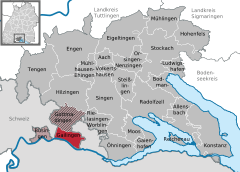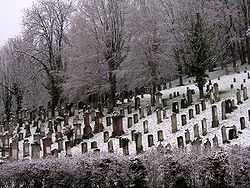Gailingen
| Gailingen | ||
|---|---|---|
|
Rhine River at Gailingen | ||
| ||
 Gailingen | ||
Location of Gailingen within Konstanz district 
 | ||
| Coordinates: 47°41′49″N 8°45′18″E / 47.69694°N 8.75500°ECoordinates: 47°41′49″N 8°45′18″E / 47.69694°N 8.75500°E | ||
| Country | Germany | |
| State | Baden-Württemberg | |
| Admin. region | Freiburg | |
| District | Konstanz | |
| Government | ||
| • Mayor | Heinz Brennenstuhl | |
| Area | ||
| • Total | 13.17 km2 (5.08 sq mi) | |
| Population (2012-12-31)[1] | ||
| • Total | 2,772 | |
| • Density | 210/km2 (550/sq mi) | |
| Time zone | CET/CEST (UTC+1/+2) | |
| Postal codes | 78262 | |
| Dialling codes | 07734 | |
| Vehicle registration | KN | |
| Website | www.gailingen.de | |
Gailingen is a town in the district of Konstanz in Baden-Württemberg in southern Germany.
It is situated in the southern part of the landscape called Hegau in a unique location on the northern bank of the Rhine River (High Rhine) just across from Switzerland and close to the Lake of Constance. It is therefore also called Gailingen am Hochrhein ("G. on the Upper Rhine"). The population currently is 3070.
History
Founded over 1,000 years ago, Gailingen was first mentioned in a document in 965 A.D However, the village probably dates back to the 5th century when the Alamanni settled in the area. The name “Gailingen” literally refers to “the people of Geilo,” one of the Alamanni leaders.
In the 11th century, a family of noblemen owned the area and probably erected a castle on the Rauhenberg mountain. This castle is gone for long already but left its name on that part of the mountain. In the 14th century, ownership was transferred to the former noble family of Randegg, which left her sign of a lion’s head in the town’s shield.
The town changed hands numerous times in the course of the following centuries. In 1540, the neighbouring city of Schaffhausen (in Switzerland) purchased one third of the domain; the other parts were owned by several families, with the Liebenfels family being responsible for the construction of a lovely small castle called “Liebenfelsisches Schloesschen” in 1750.

Beginning in the mid-17th century, Gailingen became the home of several Jewish families and gradually became one of the largest Jewish communities in the south of Germany. They built a synagogue, school, hospital and old people’s home, and their population reached a number almost as high as that of the non-Jewish population. In 1870, the town elected its first Jewish mayor. Seven years later, both Jewish and non-Jewish children were attending the same school. Members of both faiths were living together peacefully until Hitler’s rise to power. In October 1940, over 200 Jews from Gailingen were rounded up from their homes to be deported to France.
Infrastructure
In 1950, Gailingen became the seat for a rehabilitation clinic, and in 1972, a second one specifically addressing young people followed. A new church and a new school were built as well. What used to be a largely agricultural village is now a modern town, catering to tourists from all over the world. Due to its beautiful location, clean air, and peaceful surroundings Gailingen was awarded the title “national health resort” in 1977.
| ||||||||
References
- ↑ "Gemeinden in Deutschland mit Bevölkerung am 31.12.2012 (Einwohnerzahlen auf Grundlage des Zensus 2011)". Statistisches Bundesamt (in German). 12 November 2013.

